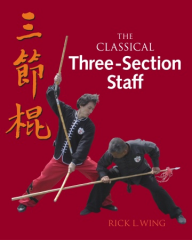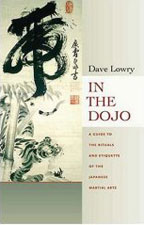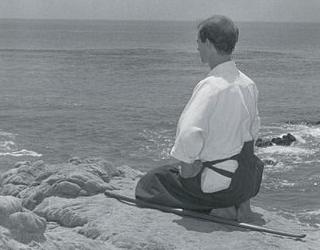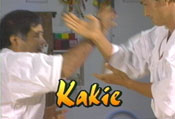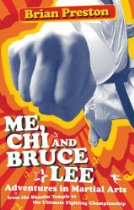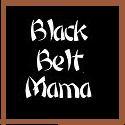The Classical Three Section Staff
I've played with a lot of weapons in my day, but the three section staff is a scary one. Does any other weapon scream quite so clearly "hey, hit yourself in the head!"
That's why I decided to check out "The Classical Three Section Staff" by Rick L. Wing.
I had my reservations about the book at first because it seemed like a normal color-by-numbers martial arts text (show a couple pictures, explain some foot positions, call it a day).
Although "Three Section Staff" does follow a pretty standard setup, I was pleasantly surprised by the quality of the content. The author provided excellent information about the history of the weapon and wrote in a very approachable manner. At no point did Wing try to sound like the master of all things staff.
One of my favorite parts of the book was in the beginning when Wing discussed the hand positions used with the staff. Seeing his pictures and examples of how the postures could be used was very enlightening.
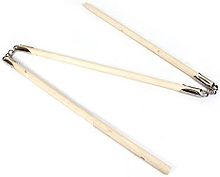
Example of a Three Section Staff
Rather than trying to pass on a whole "Style", Wing geared the bulk of his book around a single two-man form. The form is a sample combative engagement of the three-section staff vs a spear. As Wing explains it, the techniques contained in this single form allow the practitioner to understand the core principles of the weapon. Therefore, the methods used here can be used anywhere.
The pictures contained in the book are very well taken and the angles help demonstrate what is happening. Although I personally haven't learned the form contained in the book, I have gleaned a lot from the ideas discussed.
Right now in my training I am not trying to become an expert at three section staff. If I ever did want to significantly increase my proficiency, I would certainly use this text as a highly valuable resource.
Overall, Ikigai108 gives "The Classical Three Section Staff"…
Would you like to purchase this book? Check it out here!
An Obese White Gentleman in No Apparent Distress by Riki Moss
Typically, when I'm asked to review books related to the martial arts, I'm asked to review manuals or historic overviews. It's rare that a martial arts novel comes up, but An Obese White Gentleman in No Apparent Distress is just that. The thing about this book, is that although it's a "novel," it's based on actual recordings of deceased Terry Dobson, a beloved Aikido master.
One would think that the book would be almost exclusively about Aikido, and although there are some chapters that talk about the dojo, this isn't what you get. The best way to describe the book would be that it's about an unhealthy Aikido master who loses his mojo and then finds it again through love.
I have to be honest about it. Although Moss is an descriptive writer and she paints a vivid pictures of scenes as she writes them, I'm a bit of a prude when it comes to things related to sex and I wasn't sure how I felt about the main character "Max" (based on Terry Dobson) and his sexual encounters. I can read chick-lit all day long and it doesn't much bother me, but when it's based on an actual person, a person of stature in the martial arts community? I guess I just like to think of highly ranked martial artists with their clothes on.
If you're looking for a glorified portrayal of a martial arts master though, you won't find it here. This book is a very honest look at "Max," his insecurities, his struggles, his mistakes and his demise as he suffers from serious health issues that eventually take his life before his family is really ready to let him go.
There are some accounts, based on recordings of Terry Dobson, about his time training in Japan as the low man on the dojo totem pole, and how he stuck it out regardless of how inhumanely he was treated at times, because he thought eventually he would learn something, really seesomething and come away being a better person and having a deeper understanding of Aikido techniques and something more meaningful as well.
One thing you do get from this book is what seems to be a very honest portrayal of a real person, not some glorified martial artist who does no wrong. Some of the things that "Max" experiences in the novel make you cringe with embarrassment for him, like how his real life master in Japan, uses him as nothing more than a big oaf to attack him and awe an attentive audience with how a small man can take down a much larger American.
I guess when I started reading this book, I expected to be in awe of "Max" and his overall character. But when all is said and done, despite his worst flaws, he still dies being a much-admired Aikido master who has touched the lives of many. This much is true-you can read this about him in many places on the internet.
As you can clearly find on the home page of Terry Dobson's web-page:
"I consider myself a technician. I'm not a guru. I'm not a leader. I have no followers. I want none. I'm a technician. I'm like a mechanic.
I wish you would see me as not a spiritual leader, but rather as a transmission specialist of a sort. I'm working on the transmission of ki, of intention. I'm heir to a legacy that comes down from many generations of Japanese warriors regarding point, or presence, about being centered under fire. I'm not the repository for the entire sum of knowledge on the subject, but I have been close to some good teachers and I do know something about it."
If you are interested in purchasing the book, you can do so through The BBM Review store.
BBM gives An Obese White Gentleman in No Apparent Distress. . .
![]()
In the Dojo, by Dave Lowry
I have over 15 post it notes sticking out of In the Dojo, reminding me of important things I need to reread.
That's a hint about how I feel about this book.
Dave Lowry is easily one of the most accomplished martial arts writers of our time, and he adds another highly valuable text to his resume with In the Dojo. Focusing on rituals and etiquette surrounding Japanese martial arts, Lowry touches upon points that could very easily fade away into the ether as martial arts become more about business rather than culture.
Many students of modern arts don't realize it, but etiquette (or reishiki) surround every aspect of classical martial training. From concepts as varying as dojo design to proper bowing, reishiki embodies what it means to be a classical warrior. Lowry tries to grant us a peak into the different methods of manner that he has discovered over his years of koryu training.
As jonesed as I am about In the Dojo, I have one important caveat – it's not for everyone. Lowry really digs into the minutiae of etiquette and does not dole out a lot of training advice. People looking for Samurai Secrets or Ninja Techniques have definitely come to the wrong place.
This book is more suited for those unfortunate individuals who find themselves captivated by the arts and all the history, culture, and quirks behind it. For these budo nerds, In the Dojo is a playground of 'did you know?' and 'ahh ha' moments.
In the Dojo is separated by concept as opposed to having a story arc like Autumn Lightning or Persimmon Wind. Should the reader be so inclined, he/she could jump around to different topics, including: proper behavior for a teacher, proper behavior for a student, the origins of the hakama, the involvement of Shinto in martial arts, and more.
As tends to happen with Mr. Lowry's books, if you buy In the Dojo, have a highlighter and post it notes nearby. There is about 10 pounds of information here crammed into a 5 pound bag and you'll need to come back from time to time to refresh.
Overall, Ikigai108 gives this book:
Would you like to give this book a shot? Buy it from the bbm store.
Power Training by Morio Higaonna
I recently had the pleasure of watching "Power Training" by Morio Higaonna. It gave me a lot of food for thought when it comes to classical karate training.
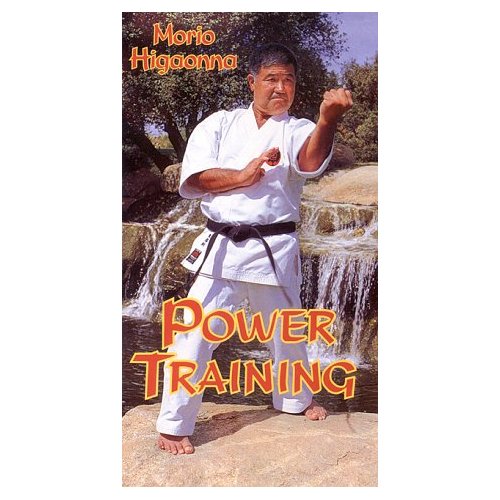
"Power Training" is all about the different methods Higaonna uses to create strong and powerful karate practitioners. Higaonna himself is renowned worldwide as a skilled karateka and strong individual. Many people marvel at his archaic methods of training and wonder how he has achieved his famed abilities.
The video begins by exploring Higaonna's stretching methods. Although this sounds pretty mundane, it is interesting to see the the ways he integrates karate style breathing into his routine. Sometimes odd looking and sometimes a bit confusing, Higaonna's stretches leave you with something to add into your own workout.
Furthermore, Higaonna shows us how to do two man warmups and exercises.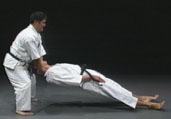
This is probably just the westerner in me talking, but these drills are a little too up close and personal with your partner for me. Higaonna is practically climbing on top of his student half the time when helping him stretch. Personally, I prefer a little breathing room.
Next in the video is something for which Higaonna Sensei is famous – Hojo Undo. Hojo Undo is the usage of old style tools and methods in order to make the body tougher and stronger. Bells, rocks, and iron bars are just a few devices used to turn the body into a fighting weapon.

Shown here are ishi sashi, nagiri game, ch’ishi, and kongo ken.
This portion of the video was very interesting, and anyone who has dabbled with the idea of including Hojo Undo in their training would benefit from seeing Higaonna Sensei at work.
Shown next is kata and various two man drills. Higaonna and his assistant Tetsuji Nakamura show different ways of using pads to improve strikes, but also demonstrate ways of using body-to-body contact as yet another way to strengthen the body.
One drill I found particularly interesting was called Kakie. This is something I have trained a bit in the past, and Tai Chi practitioners would recognize it as quite similar to "push hands". This is an excellent drill to practice spontaneity and different strikes and joint locks.
Overall, I thought this video was very well produced and contained great information. Many martial arts dvds lack a certain production quality – "Power Training" does not follow that mold. Interesting, well edited, and insightful, I would watch this again to gain further insight into Higaonna's methods.
Ikigai108 gives "Power Training"…
“Me, Chi and Bruce Lee” by Brian Preston
Tonight I watched the Nick Nolte movie, "Peaceful Warrior." I had read the book when I was first out of commission with a newly torn ACL. After a three hour hike up a mountain, the young protege says to his wise mentor, "You brought me up here to see a rock? I was so excited the entire journey. I thought you were going to show me something, not a rock." After a few minutes to allow his anger to subside, he quietly surrenders, "It's about the journey, not the destination."
Brian Preston proves this yet again in his raw and unfiltered "Me, Chi and Bruce Lee", a book about his adventures in martial arts that go from an injury while learning Kung Fu, to a seminar with Royce Gracie, to the backwoods of China, to the UFC. It is a book written with the honesty that only a true beginner in the martial arts could have written. With nothing to lose, he details his journey and his thoughts honestly and without bias. If he doesn't feel the "chi," he doesn't tell you he does. It's a refreshing and fun book.
I dug into this book enthusiastically, being injured myself, and it does not disappoint. Preston swears, and he tells it as he sees it throughout:
"Remember the holy embryo? I'm thinking at this moment Freud missed the mark when he attributed penis envy to women. It's men who have womb envy: women, without even trying, can miraculously produce an entirely new human being out of their abdomen. To match that, men in their jealousy have to invent all kinds of mystical nonsense about Holy Embryos and Immortality" (247).
He doesn't buy all the mystical nonsense that many martial artists proclaim is key and he doesn't make any bones about it. It's not all funny stuff like this though. There's also serious stuff that really makes you think (and made me upset):
"He presents a scenario where good intentions make things worse. 'A guy comes across a gang rape and interferes. He dies. Because the woman is a witness, now they have to kill her too. Is that the right outcome?'"
This as justification to not get involved, even being a skilled martial artist. This from one of Preston's instructors.
If you've ever had an interest in knowing what Royce Gracie is really like or why Jeff Monson took his clothes off at the Abu Dhabi World Championship of Grappling, you want to check this book out. Getting inside the head of serious martial artists, whatever their style, is always something interesting and unique. If ancient martial arts are more your thing, "Me, Chi and Bruce Lee" delivers there as well.
Preston spends weeks in China, watching Wushu demonstrations and asking the great Masters tough questions, like why they beat the young children dropped off to learn their ancient art. Along the way he meets many martial artists, some serious, some not, and learns something from all of them. He approaches his research and the writing of this book in a refreshingly honest way, that only a beginner could do.
Although Preston settles himself on Taiji, he provides an overview of many martial arts styles in his journey all around the world to meet the Masters and learn about their chosen martial art. It's a journey that every martial artist should take, but few will be able. Why not let Preston be your tour guide?
The book is scheduled to be released on January 6, 2009 and can be pre-ordered through The BBM Review store via Amazon for $12.21 here.
BBM gives "Me, Chi and Bruce Lee". . .
![]()


